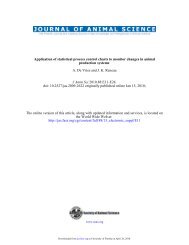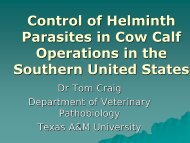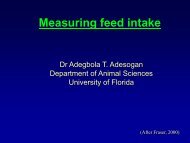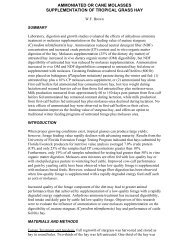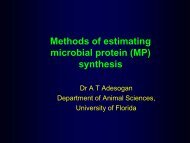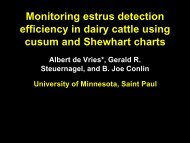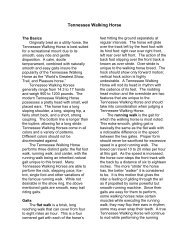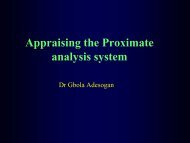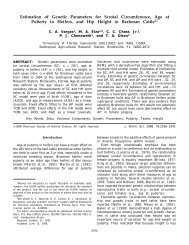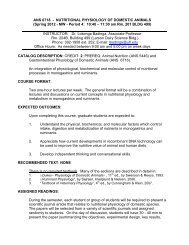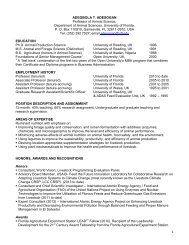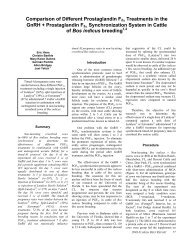In Situ Rumen Degradability Methods - Department of Animal ...
In Situ Rumen Degradability Methods - Department of Animal ...
In Situ Rumen Degradability Methods - Department of Animal ...
Create successful ePaper yourself
Turn your PDF publications into a flip-book with our unique Google optimized e-Paper software.
<strong>In</strong> <strong>Situ</strong> <strong>Rumen</strong><br />
<strong>Degradability</strong> <strong>Methods</strong><br />
Dr Gbola Adesogan<br />
,<br />
<strong>Department</strong> <strong>of</strong> <strong>Animal</strong> Sciences,<br />
University <strong>of</strong> Florida
<strong>In</strong> situ rumen degradability (ISD)<br />
Determines the disappearance <strong>of</strong> feeds incubated in<br />
a porous bag within the rumen<br />
Measures degradability (≠ digestibility)<br />
(digested feeds > pore size not considered degraded)<br />
Estimates the extent & rate <strong>of</strong> degradation<br />
Basis <strong>of</strong> formulating rations to meet protein<br />
requirements <strong>of</strong> livestock in many countries
<strong>In</strong> situ degradability graph<br />
<strong>Degradability</strong> (g/kg)<br />
c<br />
b<br />
a<br />
0<br />
12 24 36 48 72<br />
Time (h)
<strong>In</strong> situ degradability calculations<br />
<strong>Degradability</strong> = a + b ( 1 – e ct )<br />
a= zero time intercept<br />
b = slowly degradable fraction<br />
c = degradation rate<br />
t = time<br />
To account for feed outflow from rumen, (which reduces<br />
the actual rumen degradability ) we use<br />
‘Effective’ degradability = p =a+(b x c)/ (c+k p )<br />
Where k p = rate <strong>of</strong> passage (%/h)
When a, b & c values are generated<br />
for protein dissappearance:<br />
RDP = a + b (c/c+k<br />
)<br />
p<br />
UDP = b [k p / (c + kp)]<br />
a, % b, % c, /h<br />
Fishmeal 13 77 0.01<br />
Ryegrass silage 63 26 0.14<br />
Soybean meal 8 90 0.11<br />
Calculate the RDP and UDP for these feeds
Accuracy (r 2 ) <strong>of</strong> predicting<br />
digestibility & intake from ISD<br />
Factors Digestibility DM intake<br />
a + b 0.82 0.77<br />
(a+b) + c 0.86 0.88<br />
(Khazaal et al., 1993)
N degradability<br />
N degradability<br />
0.8<br />
0.6<br />
Grass silage<br />
hay<br />
Differences in the N<br />
degradability & a and<br />
b fractions <strong>of</strong> feeds<br />
0.4<br />
0.2<br />
Urea<br />
0<br />
12 24 36<br />
Time (h)<br />
48<br />
0.8<br />
Soyabean meal<br />
0.6<br />
fishmeal<br />
0.4<br />
0.2<br />
0<br />
12 24 36<br />
Time (h)<br />
48
Benefits <strong>of</strong> knowing feed N<br />
degradability<br />
Allows partitioning <strong>of</strong> protein sources according to<br />
whether they contain predomininantly:<br />
1. <strong>Rumen</strong> degradable protein (RDP)<br />
E.g. soybean meal, alfalfa,<br />
2. Undegradable protein (RUP or UDP)<br />
E.g Fish meal, bone meal,
Benefits <strong>of</strong> knowing the N<br />
degradation <strong>of</strong> feeds<br />
Allows UDP supplementation at high performance levels<br />
Allows formulation <strong>of</strong> diets to ensure synchronous<br />
ruminal supply <strong>of</strong> energy and protein<br />
1. Feed readily degradable N feeds with readily<br />
fermentable energy sources e.g.<br />
• Soybean meal and grass silage<br />
2. Feed undegradable N feeds with feeds high in slowly<br />
fermentable energy e.g<br />
• Hay / maize silage and fishmeal
Factors affecting degradability results<br />
Host animal spp & diet.<br />
Sample processing<br />
Particle size / form / fine particle losses<br />
Sample size to surface bag area ratio<br />
Bag pore size<br />
Data modelling<br />
Microbial N contamination <strong>of</strong> bags<br />
<strong>In</strong>cubation sequence
DM disappearance (%)<br />
DM disappearance<br />
(%)<br />
Effect <strong>of</strong> host animal on wheat silage<br />
80<br />
75<br />
70<br />
65<br />
60<br />
55<br />
50<br />
45<br />
40<br />
s<br />
c<br />
cs<br />
degradation<br />
Effect <strong>of</strong> animal spp. on rumen degradability<br />
80<br />
in WCW<br />
c<br />
c<br />
75<br />
c<br />
c<br />
s<br />
s<br />
s<br />
70 c s s s<br />
c<br />
65 c<br />
c c= cow<br />
60 s<br />
cs<br />
s<br />
55<br />
c<br />
s=sheep<br />
s<br />
50 cs<br />
s<br />
c<br />
45<br />
40<br />
0 20 0 4020 4060 60 80 80 100 100<br />
(Adesogan et al., 1998)<br />
Time (h)<br />
Time (h)<br />
Host animal should be identical to those that will<br />
receive the test feed
Host animal diet<br />
Determines ruminal microbial composition<br />
Recommendations<br />
– Ensure diet is balanced<br />
– Feed it at level that supports target production level<br />
– Ensure diet & test feed are ……………………….
Sample size to bag surface ratio<br />
Overfilling bags<br />
– Delays bacterial attachment & reduces. digestion<br />
Underfilling bags<br />
– May leave insufficient residue for analysis<br />
Ideal ratio<br />
= 10 – 15 mg/cm 2 <strong>of</strong> bag surface area<br />
Note : Count both bag sides (leave room for seal)<br />
e.g 4 g <strong>of</strong> DM weighed into an 8 x 14 cm bag = 4000<br />
mg/224cm 2 = 17.9 mg/cm 2
Pore size<br />
Varied sizes in literature (< 15 µm to 52 µm) due to:<br />
Conflicting aims:<br />
– Maximising bacterial colonization & fluid ingress<br />
– Minimizing loss <strong>of</strong> undigested substrates<br />
Implications<br />
– Variable particulate losses<br />
– Pressure build up which decreases<br />
digestibility.
Effect <strong>of</strong> washing procedure<br />
Forage type<br />
Parameter<br />
Washing procedure<br />
Machine<br />
Manual<br />
Corn silage a 0.48 0.16<br />
“ p 0.79 0.47<br />
Grass silage a 0.31 0.16<br />
“ p 0.62 0.47<br />
Implication: concentrates, starch-rich feeds are susceptible to<br />
fine particle losses which overestimate degradability
Microbial N contamination <strong>of</strong> bags<br />
Underestimates degradability in low N, high fiber<br />
feeds (can be up to 25%<br />
Less important in concentrates (< 10%) high in CP<br />
Causes erroneous lag and rate estimates<br />
Solution : remove microbes by<br />
• Thorough washing / Dip in ice<br />
• DAPA / nucleic acids<br />
• Correction equations<br />
• Sonication / Stomaching
Cloth type & weave pattern<br />
Mon<strong>of</strong>ilamentous vs. multifilamentous<br />
<strong>In</strong> mon<strong>of</strong>ilamentous mesh types, pore sizes are more<br />
prone be rearranged by stresses<br />
Polyester fabric is preferable to dacron
<strong>In</strong> situ method - Summary<br />
Biologically it is the most meaningful & accurate method for<br />
estimating kinetics <strong>of</strong> digestion<br />
However<br />
Difficult to standardize & laborious<br />
Has low reproducibility<br />
<strong>In</strong>accurate for soluble or small particulate feeds<br />
Requires fistulated animals<br />
Handles few samples & protracted<br />
Loss <strong>of</strong> soluble non-degradable matter<br />
<strong>In</strong>nacurate for estimating the effect <strong>of</strong> anti-nutrients
Recommend in situ procedures<br />
Diet<br />
Feeding level<br />
Bag material & pore size<br />
60:40 hay:concentrate<br />
Maintenance<br />
Polyester, 40 -60 μm<br />
Sample size: bag area 10-15 mg/cm 2<br />
Particle size<br />
No. <strong>of</strong> replicate animals > 2<br />
<strong>In</strong>cubation sequence<br />
Microbial correction<br />
> 2 mm<br />
All in, sequential removal<br />
(with machine washing)<br />
Yes, if detectable<br />
(Broderick & Cochran, 2000)
Other degradability methods<br />
contd.<br />
<strong>In</strong>cubation in rumen fluid<br />
– Labour intensive<br />
– <strong>In</strong>volves animal experimentation except if rumen fluid<br />
sourced from abattoirs<br />
– History <strong>of</strong> abattoir rumen fluid unknown<br />
– Batch culture<br />
<strong>In</strong>cubation in<br />
– Buffers<br />
– Proteolytic enzymes
Buffer degradability methods<br />
MacDougal’s buffer solubility<br />
Burrough’s buffer solubility<br />
Saline solutions<br />
TCA precipitation<br />
Tungstic acid precipitation<br />
Cold water solubility<br />
Correlation between selected buffer methods and in situ degradability<br />
Method<br />
Burroughs buffer<br />
0.15M NaCl<br />
Autoclaved rumen fluid<br />
r<br />
0.66<br />
0.47<br />
0.54
Buffer methods - summary<br />
Pros<br />
– Simple to use<br />
– OK for ranking e.g. effect <strong>of</strong> heat treatment<br />
– OK for estimating ‘a’ fraction<br />
– OK if good relationship b/w solubility & degradability<br />
• albumin is soluble but not easily degradable<br />
• Casein is degradable but not readily soluble
Buffer methods - summary<br />
Cons<br />
– Imprecise estimates <strong>of</strong> degradability especially for forages<br />
Equations are species-specific,<br />
Precipitation methods measure true protein, yet ruminants<br />
also use NPN<br />
Do not accurately estimate degradation rates
Enzyme-based degradability<br />
Bacterial<br />
Bacteroides amyliphilus<br />
Streptomyces griseus<br />
Bacillus subtilis<br />
Plant proteases<br />
Papain & bromelain<br />
Fungal proteases<br />
Aspergillus oryzae<br />
<strong>Animal</strong> proteases<br />
Pancreatin & pepsin
<strong>In</strong>-situ versus protease degradability<br />
R 2<br />
Reference<br />
S. Griseus (n= 21) 0.79 Aufrere & Cartailler ‘88<br />
Ficin (n=38) 0.85 Kosmala et al. (1996)<br />
Bromelain (n=41) 0.53 Tomankeva et al. 1995<br />
Bromelain (n=68) 0.55 Tomankeva et al. 1995<br />
(Broderick, 1999)<br />
Little success in predicting the rate <strong>of</strong> degradation
14<br />
C-Casein hydrolysis (mg/ml)<br />
0.5 Co-culture<br />
0.0 0.25<br />
S. bovis<br />
0.0<br />
S. ruminantium<br />
10 20<br />
Time (h)<br />
Single proteases can’t fully simulate microbial<br />
activity <strong>of</strong> mixed rumen microbes
<strong>Degradability</strong> references<br />
Broderick and Cochran 2000. <strong>In</strong> vitro and in situ methods for measuring<br />
digestibility with reference to protein degradability. <strong>In</strong>: Feeding Systems<br />
and feed evaluation models. M.K. Theodorou and J. France. (Editors). CABI<br />
Publishing.<br />
Noziere, P. and Michalet-Doreau, B., 2000. <strong>In</strong> sacco methods. <strong>In</strong>: J.P.F.<br />
D'Mello (Editor), Farm animal metabolism and nutrition. CAB<br />
<strong>In</strong>ternational, Wallingford, pp. 233-254.<br />
Huntington, J.A. and Givens, D.I., 1995. The in situ technique for studying the<br />
rumen degradation <strong>of</strong> feeds: A review <strong>of</strong> the procedure. Nutrition Abstracts<br />
and Reviews (Series B), 65: 65-93.<br />
Orskov, E.R., 2000. The in situ technique for the estimation <strong>of</strong> forage<br />
degradability. <strong>In</strong>: D.I. Givens, E. Owen, R.F.E. Axford and H.M. Omed<br />
(Editors), Forage Evaluation in Ruminant Nutrition. CABI Publishing,<br />
Wallingford, UK, pp. 175-188.<br />
Orskov, E.R., Hovell, F.D.D. and Mould, F., 1980. The use <strong>of</strong> the nylon bag<br />
technique for the evaluation <strong>of</strong> feedstuffs. Tropical <strong>Animal</strong> Production, 5:<br />
195-213.<br />
Adesogan, A. T. Givens, D. I, and Owen, E. 2000. Chemical composition and<br />
Nutritive Value <strong>of</strong> Forages. Field and Laboratory <strong>Methods</strong> for Grassland<br />
and <strong>Animal</strong> Production Research (eds L t’Mannetje and R M Jones) pp 263-<br />
278. CABI Publishing. Wallingford UK




